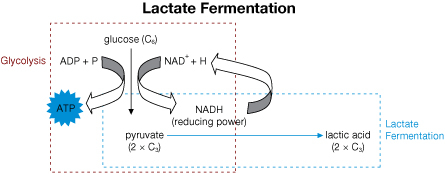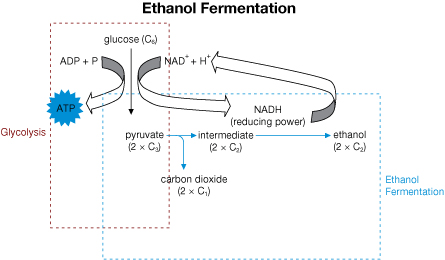Module 5 Intro
1. Module 5 Intro
1.26. Page 3
Module 5—Photosynthesis and Cellular Respiration
 Read
Read

© Shawn Pecor/shutterstock
At the end of glycolysis, three things can happen:
- Aerobic Respiration – If oxygen is present, pyruvate is transported to the matrix of the mitochondria where it becomes a part of the Krebs cycle. You will look at this in Lesson 6.
- Lactate Fermentation – If single-celled organisms, plant, or animal cells (like yeast, root cells, or muscle cells) are temporarily without oxygen lactate fermentation occurs. These cells experience an oxygen debt that can be reversed. The products of glycolysis have exceeded the oxygen supply. Pyruvate molecules build up faster than they can be used. For example, during a strenuous workout your muscle cells will convert pyruvate to lactic acid (lactate) by oxidizing NADH. NAD+ returns to be used again in glycolysis. This buildup of lactate can cause muscle cramps and fatigue. When oxygen is reintroduced (heavy breathing after a workout), lactate reforms pyruvate, which moves to the mitochondria to take part in aerobic respiration.

- Ethanol Fermentation – If oxygen is not present and not required, organisms function anaerobically. These organisms, like yeast and bacteria, convert pyruvate to ethanol and CO2(g) by oxidizing NADH. NAD+ returns to be used again in glycolysis.

Anaerobic respiration does not completely break down glucose and yields only two ATP molecules for every glucose molecule. Multicellular organisms, including humans, can only operate in oxygen-free conditions for a limited amount of time. Not enough energy is created in anaerobic respiration for multicellular organisms to carry out metabolic processes. Organisms that only rely on anaerobic respiration are typically unicellular (bacteria and yeasts).
 Watch and Listen
Watch and Listen
You may find that the readings on pages 190 and 191 of the textbook will help you understand the concepts you just learned about. The readings may also help you understand the animation Lactate and Alcohol Fermentation. This animation shows the redox reactions that occur during fermentation by indicating the role of NADH, ATP, and pyruvate.
 Self-Check
Self-Check
SC 4. Carbon dioxide is a product of __________.
SC 5. What kinds of cells carry out anaerobic respiration?
SC 6. What is the ATP output of anaerobic respiration?
 Self-Check Answers
Self-Check Answers
SC 4. Carbon dioxide is a product of alcohol/ethanol fermentation.
SC 5. Cells that carry out anaerobic respiration include the following: single- celled organisms like yeast and bacteria; plant cells submerged in water; cells deep within a multicellular organism without direct access to oxygen; and cells temporarily lacking oxygen (muscle cells).
SC 6. Anaerobic respiration yields two ATP molecules for every oxidized glucose molecule.
SC 7. You will match molecules with a statement in this exercise.
 Try This
Try This
TR 1. Anaerobic Respiration → Fermentation
Now that you have explored anaerobic respiration, it is time to see how well you understand and can explain the process of respiration under anoxic conditions. Go to your Lesson 5 Assignment and complete the Try This questions.
 Read
Read
biofuel: ethanol produced during the fermentation of biomass
biogas: methane captured from animal waste that is used as fuel
Fermentation is used to produce a number of commercial products, such as cheese, breads, and beer. Different strains of bacteria produce unique fermentation products as a result of the genes they express and are, therefore, used to produce specific commercial products. Some examples are listed in the following table.
Commercial Product |
Fermentation Product |
Type of Organism Involved |
yogurt and some cheeses |
lactate (lactic acid) |
bacteria |
vinegar, ketchup, mayonnaise |
ethanoic acid (acetic acid) |
bacteria |
buttermilk |
2, 3-butanedione |
bacteria |
Swiss cheese |
propanoic acid and carbon dioxide |
bacteria |
biogas |
methane |
bacteria |
beer, wine, spirits, and biofuel |
ethanol |
yeast and some bacteria |
bread |
carbon dioxide |
yeast |
Two particularily interesting products because of their potential to replace fossil fuels are biogas and biofuels. To learn more about the uses of biofuel and biogas, read "Ethanol Fermentation and Fuel Production" and "Ethanol Production" on pages 191 and 193 of the textbook. Also read “Energy from Manure” on page 192.